 Home
Home Up
Up Search
Search Mail
Mail
NEW
Measurements on passages at Knowth
Victor Reijs has been able to determine the azimuth of the westerly
passage of Knowth and an indicative measurement of the easterly
passage azimuth has been made.
According to Brennan ([1983],
page 102) the easterly and westerly passage of Knowth would be aligned
with equinox, the below will show this is not true.
Westerly passage
A plan has been made to measure the
westerly
passage at Site 1 of Knowth.
Azimuth
The minimum azimuth of the westerly passage is
determined using the following methods:
- a compass reading using a
work
light
at the position between Orthostat 31 and Orthostat 32 (just beyond the
bend in the passage).
Due to this work light no access to the passage was needed. This light
was visible outside the chamber and it was aligned with the standing
stone
in front of the passage (on the right side of the standing stone,
looking
towards standing stone and entrance). This line of sight was extended
to
around 100 m at the fence of the neighboring field.
The compass reading was a magnetic azimuth of 266.9° (in 2000), and
compensating this
gave an azimuth value of 260.6° +/- 35' - measurements with a GPS
A measurement was done in front of the passage entrance and another
measurement was done some 3.2 km from Knowth using the same line of
sight
as used with with the compass reading (now the line of sight was
further
extended by going up the mount and using binocular to align the
measurements).
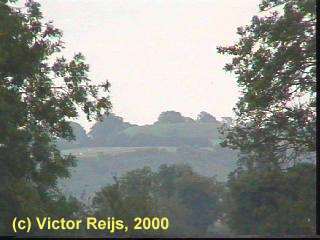
View from the 3.2 km GPS measurement towards Knowth
This gave an azimuth measurement of 259.6° +/- .2°. The
error
stated is based on the two measurements, but the method used
(going
up the mound) will have decreased the accuracy. How much is unknown.
- measuring the azimuth from the
book
of Knowth by G. Eogan (figure 25).
This reference gives an azimuth of 263° +/- 1°. - Measurements
of azimuth of the main passage by T.Ray &
F.Prendergast,
Nov.1997 (pers. comm. 2000 and Prendergast [2002]) using gyro theodolite:
They found an azimuth of: 258.6° +/- 1' (sun at 17.8 days after
autumn
equinox or 18.6 days before spring equinox in 3300 BCE)
- Measurements
of azimuth of the inner chamber
using gyro theodolite has a direction of 278.2° +/- 1' by T.Ray
&
F.Prendergast,
Nov.1997 (pers. comm. 2000) (sun at 11.2 days before
autumn
equinox or 11.4 days after spring equinox in 3300 BCE)
Evaluating these value, it is save to say that the minimum (green)
azimuth
of the western passage is around 259°.
Apparent altitude
The apparent altitude window that
could
allow light inside the passage up to the end of the passage, is between
0° (the horizon [barely no problems with trees!] and the top of
Kerb
stone K74 are both at this apparent altitude) and 0.4°.
This 0.4° is determined by looking at the height of the first still
existing Orthostat 80. It could be that the maximum apparent altitude
would
have been a little bit bigger, but not more than 1.4°.
Sunniness of westerly passage

Using a stylized map of the westerly passage (taken from G.
Eogan, 1986), the sunniness of the
passage
has been calculated (bearing in mind that I only looked at sun further
away than Ort. 31). It is 2.1% or 8 days per year of sun on the Ort. 32
(and perhaps further).
This sunniness is comparable with Newgrange and Maeshowe reappearing
phenomena.
Easterly passage
Azimuth
Because of the concrete building (within the pre-christian settlement)
in front of the easterly passage, no azimuth measurements can be done
in
a simple way!
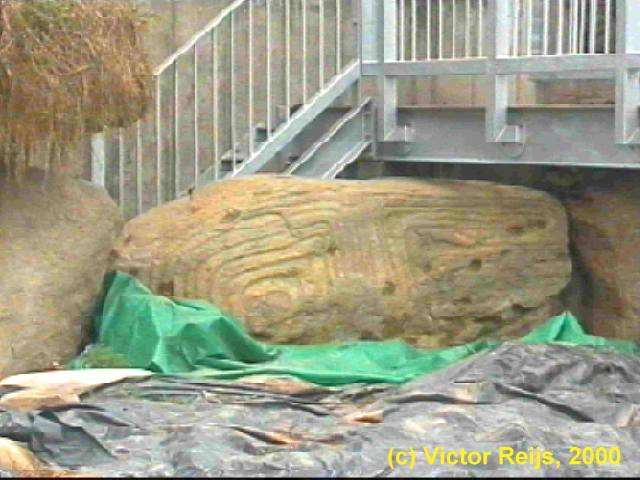
Kerb Stone K11 and the concrete wall
plus bridge in front of easterly passage
- A crude azimuth measurement with
a
compass
was done and gave 83° (as a compensate value). The error is
unknown,
but can be a few degrees.
- measuring the azimuth from the
book
of Knowth by G. Eogan (figure 24).
This reference gives an azimuth of 87° +/- 1°. - Measurements
of azimuth by F.Prendergast, June1985 (pers. comm.
2000 and Prendergast [2002]) using
gyro theodolite:
He found an azimuth of: 85.0° +/- 1' (sun at 5.9 days after spring
equinox
or 5.7 day before autumn equinox in 3300 BCE)
So using these values and the experience from the westerly passage, I
assume
that the azimuth of the easternlypassage will be around 85°.
This passage almost directed towards Dowth (83° 40')
The horizon view at this moment is blocked by a shed (is removed in the
mean time) and trees (difficult to remove).
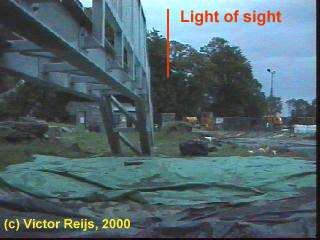
The rebuild entrance now looks like this:
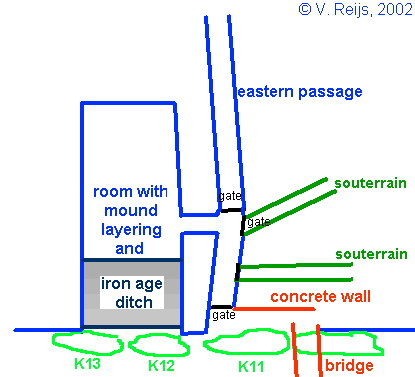
Apparent altitude
The apparent altitude of the view could not be measured in real live. It
could be that the top of kerb stone K11 is at a higher level than
the
ceiling of the passage (see picture 17 in Knowth,
G. Eogan). In that case no sun light can penetrate the chamber.
The height of the top rim of K11 is projected on the present eastern
passage:
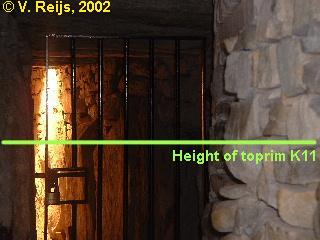
Looking at the above picture it looks like the passage ceiling has
been
rebuild higher then when the excavation took place. This issue is being
studied.
The horizon could have a maximum
apparent altitude
of around 0.4° (Donore Hill).
Changing the concrete wall
Victor Reijs has put forward a proposal to Duchas to change the walls
of
the modern concrete room, so that light can penetrate the easterly
passage
(using a state-of-art method for integrating past, present and future
in
own design). This change would enhance the building very much, because
it integrates the neolithic, the pre-christian and the present times in
a much better way. He is still awaiting their reaction.
Seeing the sun in the westerly passage
- Sunset at equinox has been
observed. The sun has been seen to touch
Orth. 73 on Sept. 22nd, 2000 at 18:46 BST (it would go
further
if the modern wooden frame was not there). Combining this now with my
measurements
of the passage, then this sighting coincides quiet well with the
259°
direction for the whole western passage.
- The sun has been seen inside the westerly passage by quiet a few
people.
A penetration of 1/4 of the length of the passage has been seen on
Sept.
25th, 1999. No visits have been done later.
- Now I need actual visual proof that the sun will reach that
location
(near
Orth. 32). I think Oct. 10th 2000 (or March 2nd,
2001) is the best date, but I assume +/- 4 days will also do the job
(but
less good).
- Another issues is how the recumbent stone
in
front
of the passage will interfere with the sun's light in the chamber. I
have
the idea that a kind of reappearing (like at Maes
Howe) could happen due to this standing stone within the western
and
eastern passage.
Acknowledgments
I hereby want to thank Clare Tuffy, who provided the permission to walk
around Knowth to do my measurements. Ben Devine, Colm O'Brien, Anthony
Murphy and Richard Moore supported me in many ways to do these
measurements.
Disclaimer and Copyright
 Home
Home Up
Up Search
Search Mail
Mail
Major content related changes: Nov. 14, 2000





